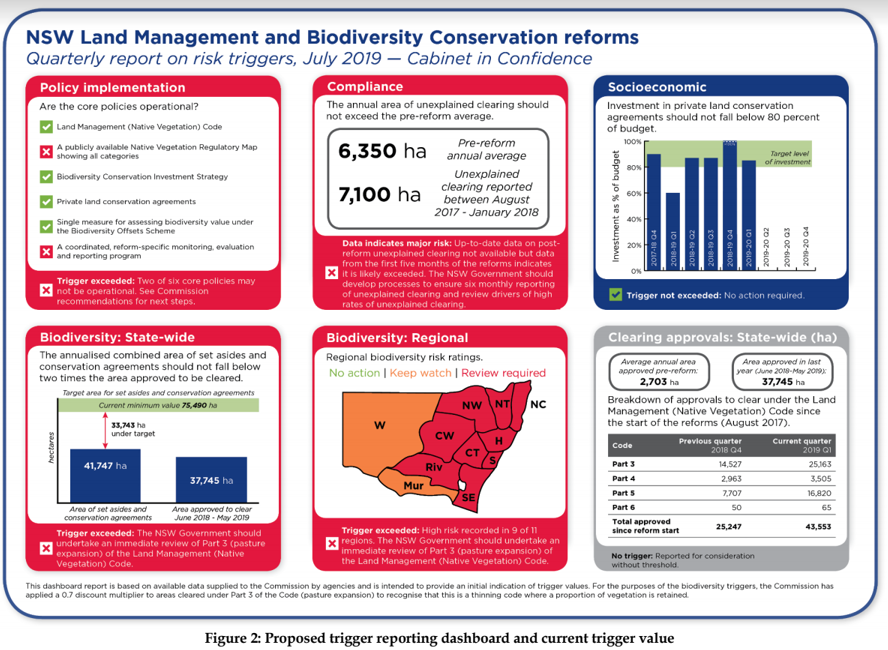Late last Friday, while everyone was transfixed by the burgeoning COVID-19 crisis, a confidential review of how the NSW native vegetation laws are tracking was quietly and reluctantly released. The news is not good.
By Rachel Walmsley, Director of Policy and Law Reform, Sydney
It was clear to EDO from the moment the old native vegetation laws were repealed in 2016, that landscapes and catchments across the state would be at risk from the inappropriate levels of clearing allowed by the new laws. While lawyers usually enjoy being proved right, having confirmation of the sheer scale of clearing and biodiversity destruction now happening in NSW is devastating. The level of clearing confirmed by the new expert report shows our laws are operating to put greater stress on landscapes that are already suffering the impacts of climate change, drought and bushfires. Instead of building resilience and ensuring healthy and productive country, our laws are degrading the land.
This secretive review conducted by the Natural Resources Commission (NRC) at the request of the Premier in early 2019, was required because of a political agreement when the new laws were made – essentially requiring a review should clearing exceed an annual rate of 20,000 hectares in any 6 month period. (In our view, such a rate of clearing was almost inevitable due to the introduction of new codes that essentially brought back broadscale land clearing). The existence of the review trigger and the resulting report were eventually made public by the media and through independent parliamentary processes – it was not a transparent process.
The NRC was directed to focus on the adequacy of the trigger for reviewing the native vegetation regulatory scheme. It concludes that having a single amount of clearing as a trigger is inadequate due to the range of complexities and areas of concern. Instead, the NRC recommends a set of triggers to assess the scheme, and it is in the proposed trigger ‘dashboard’ presented in the report that there is some truly alarming data.

In summary, the report shows:
- Clearing rates have increased almost 13-fold – from an annual average rate of 2703ha a year under the old laws to 37,745ha under the new laws;
- Biodiversity in 9 out of 11 regions is now at risk;
- Unexplained clearing has increased, with the NRC concluding “compliance frameworks are inadequate and high rates of clearing pose a major risk”;
- The proposed ‘set aside’ areas and areas managed under conservation agreements that were supposed to offset cleared areas – ie, the government’s whole justification for relaxing rules and introducing self-assessable codes – are woefully inadequate being 33,743 hectares below the minimum required area.
The NRC also confirmed the fundamental flaws previously identified by EDO, that key elements of the regime are still missing [see our three part series on Implementation of the NSW land clearing laws]. Most significantly, there is still no complete regulatory map to underpin the whole regime. This is regulatory failure at its most blatant.
Given the recent horrific summer of bushfires, the legacy of severe drought and the broader unpredictable impacts of climate change, we need laws that build the resilience of healthy and productive landscapes. We need transparent processes to properly and scientifically assess our laws to see if they are actually working. Where there is regulatory failure, we need proper review and reform.
Instead, the NSW Government published a lacklustre response to the report (available at: https://www.dpie.nsw.gov.au/news-and-events/land-management). The response is not commensurate to the seriousness of the issues identified in the review. The response merely “notes” the recommendation that the regulatory map be finalised and “notes” the need for a process to nominate areas of outstanding biodiversity value. (These fundamental elements remaining absent even though the laws commenced two and half years ago). The government response agrees ‘in principle’ to consider and develop monitoring and review processes on a number of points. These will be all in-house reviews, with no commitment to independent scrutiny. There is no commitment to actually fixing the law or ensuring greater public transparency outside of the formal 3 and 5 year reviews.
The level of clearing highlighted by the NRC report confirms the need for a wholesale rewriting of land clearing laws in NSW to put the emphasis back on conserving landscapes and building resilience. Continuing to internally ‘consider’ and review the land management scheme, will result in simply recording the devastation as it continues, rather than intervening now to turn around the trend of surging clearing rates and rising biodiversity loss.
Reluctantly and quietly releasing a damning report on a Friday afternoon, while the community is distracted by the anxieties of the COVID-19 age, should not – and does not – go unnoticed. EDO will continue to be a watchdog, to seek positive reform, and to use the law to protect our unique environment.
The report is available here. The image above is from page 4.





